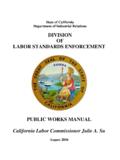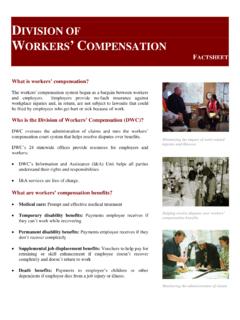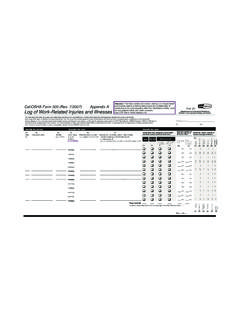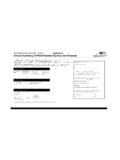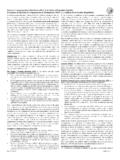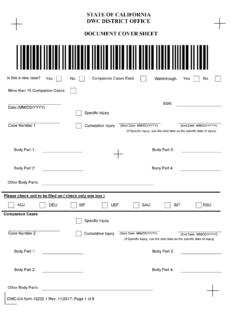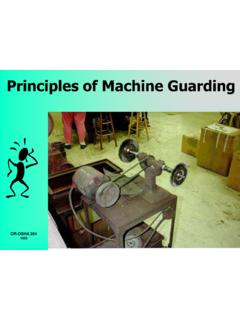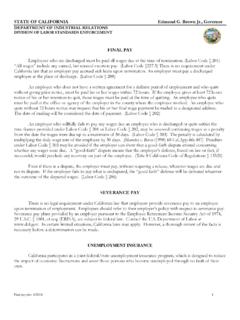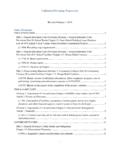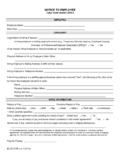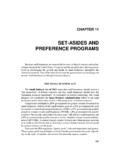Transcription of Fitting the Task to the Person - California Department of ...
1 Ergonomics for VerySmall BusinessesCalifornia Department ofIndustrial RelationsCal/OSHA Consultation ServiceEducation UnitFitting the Taskto the Person :Publishing InformationFitting the Task to the Person : Ergonomics for Very small businesses was developed by theEducation Unit, Cal/OSHA Consultation Service, California Department of IndustrialRelations. The document was prepared for publication by the staff of the PublicationsDivision/CDE Press, California Department of Education. It was distributed under theprovisions of the Library Distribution Act and Government Code Section 2000 by the California Department of Industrial RelationsCalifornia Department of Industrial RelationsCal/OSHA Consultation ServiceEducation UnitNo one is required to use the information in this booklet.
2 Thisbooklet is not intended to provide employers with informationon how to comply with Cal/OSHA values and welcomes your comments about ourbooklet. We want to provide the best possible service to em-ployers and This information Is ForThis booklet presents basic ergonomic principles forvery small businesses . It does not include issuesspecific to computer use, construction or agricul-ture. You may need the advice of an ergonomicsconsultant or other outside experts. The field ofergonomics is dynamic, and new information isconstantly being developed. Checkperiodically for updated references listed on page 11provide more in-depth Should YourWork Fit You?
3 3 Reduce InjuriesMany people get work-related backinjuries, wrist disorders and assortedstrains and sprains. The injuries mayoccur suddenly ormay developslowly over the fitbetween you andyour work canhelp prevent theseinjuries. Chronicinjuries may meanthat you are nolonger able to docertain parts ofyour job or thatyou have to leaveyour line of work Profitsand IncomeReducing injuries saves medical costs, lost work time andrelated costs of replacing an injured worker. When there is abetter fit between you and your work tasks and environment,you can often work faster and more efficiently. When youwork in awkward and uncomfortable positions, you mayhave difficulty doing your job correctly.
4 Errors aremore common, and work sometimes needs to the Task to the PersonFitting the task to the Person means adjusting the way in which work is done, modifying equipment,job design and layout and adjusting for the physical capabilities of workers so that work does notcause musculoskeletal disorders. Move things in closer and within easy reach. Raise or lower your chair or work surface. Try to build in adjustability and redesign workareas for a comfortable work in a comfortable you can, put the work in front of you at about waist may be able to do this by making simple changes:Lift for a long work everyone you work with the importance of smart lifting: Train new employees to use a handtruck or to get help with large loads.
5 Avoid bending andtwisting your backwhen you lift. Bend your kneesand keep your backstraight to lift loadsfrom the The work istoo low. The work istoo to design work so that loads are lighter, heavy loadsare stored at waist height, and less lifting is the right tool for the modifications to account fordifferences in size and strength. Be flexible and modify yourexpectations according toemployees size and strength. Provide adjustable equipmentand work stations to accommodatedifferences in employee size. Change the size or weight of theload to accommodate differencesin strength. Use the right tool for the task.
6 Use a tool with a handle thatfits comfortably in your handand lets you work in acomfortable position. You may be able to reduce forceand repetition by using a powertool. Try to redesign tasks thatrequire repeated, forcefulhand and tool handles to accommodatedifferent heightsA poster for retail/wholesale business is posters available include health care, den-tistry, restaurant/bar, cosmetology, and auto fold-out poster (11x17) perforated in center Back of poster blankBack ofposter-blank(do not printinstruction)9 Repeated or prolongedreaching, twisting,bending, workingoverhead, kneeling,squatting, holding fixedpositions or pinch grips Repetitive work with thesame types of motionsover and over again usingthe same muscles,tendons, and joints Forceful exertions when theamount of muscular effortis expended to hard orsharp surfaces The body or body partspress against hard orsharp surfaces Continuous or highintensity vibration withtools, vechicles,equipment or platforms!
7 ! Pain Muscle tightness Numbness or tingling inthe arm, leg, finger, orhand, especially in thefingertips at night Decreased range of motionin the joints Decreased grip strength Swelling of a joint orpart of the arm, hand,finger(s), or leg Fatigue, achiness,discomfortWhat to Do If You HurtMusculoskeletal Disorders (MSDs) (also known as cumulative orrepeated trauma, repetitive strain injuries or repetitive motioninjuries) may occur when the task does not fit the worker. Youmay have heard of MSDs in terms of muscle strains, ligamentsprains, or back, wrist, neck or shoulder pain. It is not true thatMSDs hurt only while you are working.
8 MSDs can hurt at anytime while you are working, sleeping, or watching MSDs can hurt very little, and other times MSDs canflare up and cause extreme nothing is done to improve the fit between the Person and thework, permanent damage can occur. MSDs are difficult todiagnose and difficult to treat in later phases. You need to payattention to warning signs to avoid permanent action as soon as you become aware of warning signs. Earlyaction can prevent the loss of function and serious injury. If aninjury does occur, seek medical attention promptly and followCal/OSHA and workers compensation guidelines for reportingwork-related illnesses and injuries.
9 !Fatigue/StiffnessPain Comes and GoesContinuous PainLoss of Function!MusculoskeletalDisorderWarning SignsConsider SeekingMedical signs ofmusculoskeletaldisorders:Take Action!Understand what can happen if you donot pay attention to warning That Will Pay OffImprovements in lifting, work position and tool use and reductionsin awkward posture and forceful exertions will pay off. Taskredesign is often important for long-term an improvement should make the work physically easierand relieve discomfort. However, if modifications require you touse new muscle groups or different parts of your body, the workmay feel awkward, or you could feel fatigued in ways that you didnot before.
10 This discomfort should fade in a few days as youbecome conditioned to the new procedures. Persistent fatigue ordiscomfort is a sign that a change is not process of making improvements is not exact. Expect to try outimprovements, determine their effectiveness, and either modifythem or discard them in favor of alternatives. Keep up with changesin your trade and be aware of new opportunities for you plan to purchase new equipment or remodel the workplace,use that opportunity to make changes that will make it easier to fitthe work to the Up: Evaluate Effectsof Improvements. The Process of Ergonomic ImprovementsLook for Opportunitiesfor and your co-workers will often have the ideas you need forimprovements.
